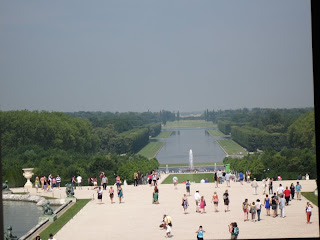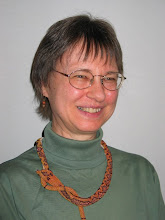Another hot day. I have noticed that a fair number of Parisian women use inexpensive , folding fans to help them tolerate the heat. Our breakfast today was an apple tart and the warm, peach-flavored, Nestea iced tea. That drink is very popular in Paris. I was really craving an iced coffee at this point but none was to be found.
Since the museum we wanted to visit didn't open until 11:00AM, we took the time to go bead shopping. I didn't have time before we left the U.S. to do much research on bead shopping in Paris but I did have a list of shops from the Wild Things Beads website (
http://www.wildthingsbeads.com/article-bsp.html). Unfortunately we didn't have a good street map to make things easier, but we did manage to find find the wholesale district on the Rue de Temple.
The wholesale bead, button, and accessory district shares space with the sex district so it was an interesting walk. Here is the start of the district, a less sleazy view than most of what we saw.

A lot of the shops are down small, winding streets that are barely wide enough for one car. The atmosphere was charming but the shopping was disappointing. The few bead shops that I explored either sold stones like turquoise or carnelian or finished jewelry. The wholesale minimum was 100 or 150 Euros and the selection was not different enough from what I can get in the U.S. to prompt me to make a wholesale order. That may be the result of globalization.
The biggest shop that I explored was the Fried Freres at 13 Rue de Cairo (
http://www.friedfreres.fr/). I am sorry to say that the website is far more exciting than the actual store. It reminded me of the old-time bead and trim stores that have been priced out of the garment district in New York City. They had beads on sample cards, a few beads in a case, yarn and sequined trim by the yard, and a few dyed seed beads thrown in. Those cute gummy beads featured on their website were nowhere to be found. I saw a few beads that were of interest but there just wasn't enough to tempt me to spend hours in the shop (with Don translating) to make up a 150 Euro order. I was going to have Don ask if I could take a catalogue but decided that there wasn't enough in the catalogue to help me. We couldn't find the museum of steel cut tapestries and purses; I think it has been replaced by their finished jewelry department.
I am glad that I looked at the bead district but disppointed that I didn't find anything to buy. Next time I will try to find some retail shops to explore--every store that we saw had signs with the French equivalent of "Wholesale Only." Next time I will also make a REAL effort to be in Paris when the flea markets are open.
We grabbed lunch at one of the ubiquitous panini shops (eating outdoors, of course) and headed for Les Arts Decoratifs museum (
http://www.lesartsdecoratifs.fr/). On the way, we walked by another of those Art Nouveau metro entrances.

We have no photos of the Les Arts Decoratifs because taking photos was not allowed, but it is a beautiful museum. The had a temporary exhibit of Madeline Vionnet gowns that spanned her exceptional career as a couturier from 1912-1939.

Poster for Vionnet exhibit.
We also spent a lot of time admiring the exquisite permanent jewelry collection (complete with fabulous Lalique pieces) and watching the Rube Goldberg-like, mechanical toys that doubled as musical instruments and the 100 singing rabbits installation. Touring the gallery of rooms decorated in the styles of each decade of the twentieth century was interesting because there was quite a bit of difference between European and American decorating trends.
I did see some fabulous modern jewelry (that I couldn't afford) in the gift shop but the only jewelry involving beads were some basic beadwoven cuffs. The jewelry that I saw in France seemed to reflect the taste in clothes. Just like the common observation that French women buy classic clothing, they seem to buy classic jewelery (like a string of stone beads) that can be worn with many outfits. The college crowd goes for jeans and t-shirts and not much jewelry.
Having time left and Museum Pass in hand, we then headed for the Musee de Cluny (
http://www.musee-moyenage.fr/), the National Museum of the Middle Ages. We had tried to see this museum when we were in Paris in 2007 but it wasn't open because the staff could not get to work in the midst of the transit strike.
One view of the Musee de Cluny (taken from the website).
The museum is housed in two historic buildings. The first is is a Roman bath built in the late first century A.D. Over that was built the Hotel de Cluny in the late 15th century to serve as the Parisian residence of the Cluny abbots. Part of the museum grounds is made up of a modern interpretation of a garden from the Middle Ages.
We wandered through the permanent collection of medieval artifacts, the temporary exhibit of items relating to the bath mounted in the Roman bath, and the Lady and the Unicorn tapestries. In the gift shop, I found three postcards on one of my favorite topics:

rabbits in the unicorn tapestries. Here is one of the postcards.
After the museum, we headed to the Luxembourg Gardens so that Don could rest his back for a few moments. While he rested, I watched the huge French piegeons (bigger than those in New York) but couldn't get a good photo of one. After Don's back felt better, we raced over to see if we could get into the Pantheon before it closed. We got there 15 minutes before they closed but the guard would not let us in.
Then it was time for dinner. Following a recommendation in the Rick Steves' Paris guide, we decided to walk down the Rue Moufetard to a local cafe called the Cave de Bourgogne. The walk was fun as we observed the plethora of restaurants along the way--much more variety of cuisines than we had previously seen.
The Cave de Bourgogne was definitely a local place with neighborhood folks gathering for a drink and a menu all in French. Between Don's French, my culinary knowledge, and our helpful waiter's limited English, we figured out what was on the menu. Don had a steak with dipping sauce, fries, and a green salad and I had leg of lamb with a sauce, fries, and a green salad. Both were plates were simple but good. For dessert we split a creme brulee and--wonders of wonders--iced coffee. Needless to say, we ate outside because of the heat.
We wandered back up the Rue Moufetard to the subway, stopping to buy some pastries for the morning because we had to leave for the airport before the patisseries open. It doesn't get dark in Paris until about 10:00 PM so you can still see a lot as you wander around.



























































